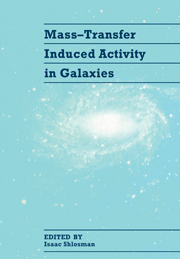Book contents
- Frontmatter
- Contents
- Preface
- List of Participants
- I INTRODUCTION
- II THE INNER PARSEC
- III THE CIRCUMNUCLEAR REGION
- IV GAS DYNAMICS AND STAR FORMATION IN BARRED AND NORMAL GALAXIES
- V NUCLEAR GAS AND LARGE-SCALE PROPERTIES OF AGN AND STARBURST HOSTS
- VI HOST GALAXY-AGN-NUCLEAR STARBURST CONNECTION
- Starbursts, Quasars, and their Environments (Invited paper) 234
- Nuclear Fueling in Two-Component Star-Gas Disks (Invited paper) 251
- Radio Loud Far-Infrared Galaxies 263
- Massive Central Black Holes as Generators of Chaos and Drivers of Large-Scale Dynamics
- Self-Gravitating Gas Dynamics: Growing Monsters and Fueling Starburstsin Disk Galaxies
- Radial Inflows in Disk Galaxies: Effects of Star Formation 279
- Self-Gravitating Gas Dynamics in a Galactic Central Region
- Nuclear Inflow under the Action of Instabilities
- Mid-IR Imaging of Interacting and Non-Interacting AGNs (Poster paper)
- Imaging of MBG Starbursts: Preliminary Results (Poster paper)
- Compact Extranuclear Structures of Mkn 298 (Poster paper)
- NGC 6814: a Very Normal Looking AGN Host Galaxy (Poster paper)
- ROSAT PSPC Observations of NGC 3079 (Poster paper)
- MK 231: AGN vs. Starburst? Steps Toward a Model (Poster paper)
- Extended Starburst Activity Induced by the Central AGN: a Model for NGC 1068 (Poster paper)
- NGC 2782, NGC 4102 and NGC 6764: Evidence for Starburst-Driven Winds
- AGN Winds and Nuclear Starbursts (Poster paper)
- VII GALAXY INTERACTIONS AND INDUCED ACTIVITY
- VIII GAS DYNAMICS IN ELLIPTICALS
- IX AGN AND STARBURST HOSTS AT LARGE REDSHIFTS
- X CONFERENCE SUMMARY
- Subject Index
- Object Index
- Author Index
Nuclear Inflow under the Action of Instabilities
Published online by Cambridge University Press: 05 May 2010
- Frontmatter
- Contents
- Preface
- List of Participants
- I INTRODUCTION
- II THE INNER PARSEC
- III THE CIRCUMNUCLEAR REGION
- IV GAS DYNAMICS AND STAR FORMATION IN BARRED AND NORMAL GALAXIES
- V NUCLEAR GAS AND LARGE-SCALE PROPERTIES OF AGN AND STARBURST HOSTS
- VI HOST GALAXY-AGN-NUCLEAR STARBURST CONNECTION
- Starbursts, Quasars, and their Environments (Invited paper) 234
- Nuclear Fueling in Two-Component Star-Gas Disks (Invited paper) 251
- Radio Loud Far-Infrared Galaxies 263
- Massive Central Black Holes as Generators of Chaos and Drivers of Large-Scale Dynamics
- Self-Gravitating Gas Dynamics: Growing Monsters and Fueling Starburstsin Disk Galaxies
- Radial Inflows in Disk Galaxies: Effects of Star Formation 279
- Self-Gravitating Gas Dynamics in a Galactic Central Region
- Nuclear Inflow under the Action of Instabilities
- Mid-IR Imaging of Interacting and Non-Interacting AGNs (Poster paper)
- Imaging of MBG Starbursts: Preliminary Results (Poster paper)
- Compact Extranuclear Structures of Mkn 298 (Poster paper)
- NGC 6814: a Very Normal Looking AGN Host Galaxy (Poster paper)
- ROSAT PSPC Observations of NGC 3079 (Poster paper)
- MK 231: AGN vs. Starburst? Steps Toward a Model (Poster paper)
- Extended Starburst Activity Induced by the Central AGN: a Model for NGC 1068 (Poster paper)
- NGC 2782, NGC 4102 and NGC 6764: Evidence for Starburst-Driven Winds
- AGN Winds and Nuclear Starbursts (Poster paper)
- VII GALAXY INTERACTIONS AND INDUCED ACTIVITY
- VIII GAS DYNAMICS IN ELLIPTICALS
- IX AGN AND STARBURST HOSTS AT LARGE REDSHIFTS
- X CONFERENCE SUMMARY
- Subject Index
- Object Index
- Author Index
Summary
ABSTRACT
During the stage of galaxy formation, or because of subsequent accretion events, cold, rotationally supported matter carrying substantial angular momentum is deposited and organized in disks/rings at the outer parts of many types of galaxies. Examples are warped HI disks in spirals, disks of gas and dust in ellipticals, and polar rings around SOs/ellipticals. The observed nuclear activity in many galaxies has its origin in mass transfer from large radii into the centers of galaxy potential wells. We describe two stages of such a mass transfer process and present related numerical multidimensional hydrodynamical simulations. In the first stage, gas still carrying some angular momentum flows toward the nuclear region as a moderately inclined outer disk is attempting to settle toward an energetically “preferred orientation.” In the second stage, a nuclear accretion disk, influenced by the gravitational potential well of a central massive black hole and possibly by a coherent weak magnetic field, suffers one of several known dynamical nonaxisymmetric instabilities that drives gas deeper into the potential well and regulates its accretion onto the black hole.
INTRODUCTION
Although gas is predominantly found in spiral galaxies distributed in rotationally supported large-scale disks (∼ 10 kpc), recent observations reveal the existence of counter-rotating gaseous disks in the central regions of many elliptical and SO galaxies (Franx and Illingworth 1988; Bertola et al. 1990; Bertola, Buson, and Zeilinger 1992). The accepted interpretation of such observations is that gas in ellipticals and SOs must be of external origin.
- Type
- Chapter
- Information
- Mass-Transfer Induced Activity in Galaxies , pp. 289 - 293Publisher: Cambridge University PressPrint publication year: 1994
- 1
- Cited by

